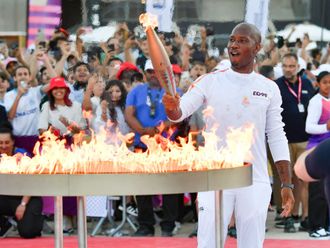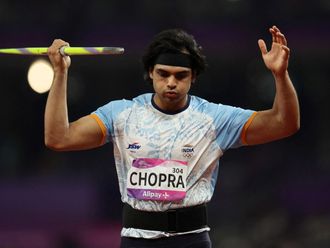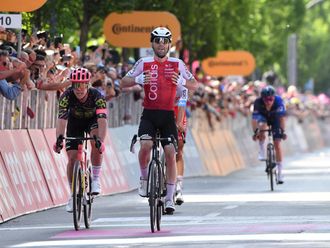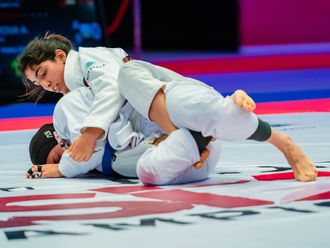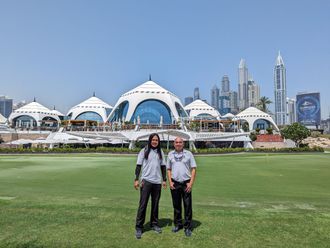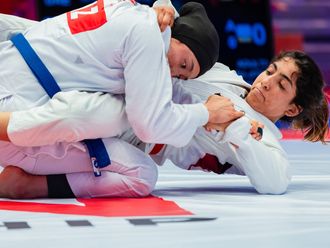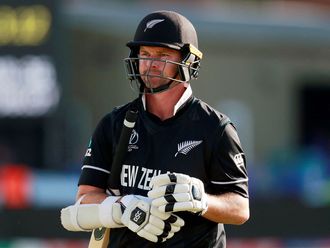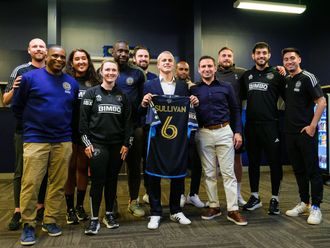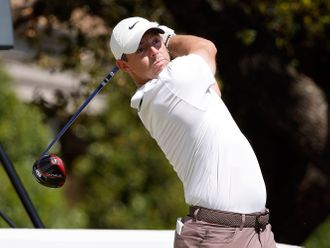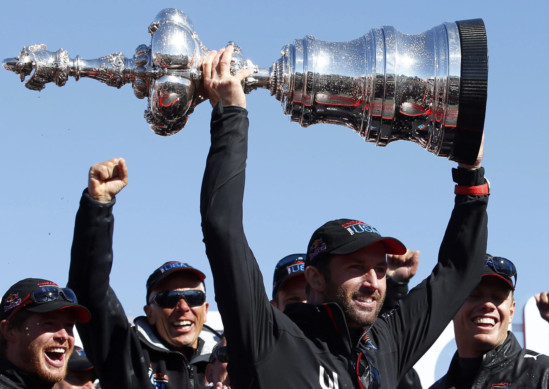
London: The brilliant television coverage of the America’s Cup gave viewers the chance to see and hear a knight of the realm doing what he does best. Sir Charles Benedict Ainslie, CBE, could be heard shouting “Jimmy, I want a higher line!” and “That’s good pressure, I want good pressure” during the finale to the most talked-about race in the history of yachting. As the giant catamaran Oracle Team USA sped across the waves towards the finish he exhorted: “This is it! This is it! Work your arses off!”
If all his comments were aimed at his 10 crewmates, those last 10 words might have been directed back home to Britain, to all the multi-millionaires among them fellow knights Richard Branson and Keith Mills and leaders of commerce who could help Ainslie to sail in the next America’s Cup for a Team GB. The time is right: there has never been anybody quite like Ainslie to be the focus of a British challenge.
At Euro 96 England’s football fans sang about “30 years of hurt”, looking back with the help of a pop song to the fading memories of the 1966 World Cup. In the America’s Cup it is 162 years and counting. The Americans won the first race off the Isle of Wight in 1851, and the trophy has never been back to Britain. “I’m a patriotic Briton with a feel for my country’s maritime history. Being involved in a successful British America’s Cup team has been a dream for me since I was about 12 years old,” said Ainslie, 36.
He focused first on single-handed sailing. Ainslie became a youth champion, Olympic champion, world champion, a brilliant tactician, the best one-on-one racer in the world, a man with a sixth sense on the water. Even in individual racing he was a strong team man, as his fellow Olympians will testify. He always learned from failure, and when he turned to America’s Cup racing disastrously, at first he tried his hand in all roles. He became a team leader, and is now widely regarded as the world’s best sailor.
Friends describe him as the most dedicated man they know. He once said of his obsessive approach to racing: “I’ve always tried to become very detached. Single-mindedness takes over to the point thatyou have zero tolerance to any other considerations.”
If last week’s races, in which the American team backed by billionaire Larry Ellison came back from 8-1 down to defeat Emirates Team New Zealand, showed Ainslie at his best, two other achievements give a telling insight into his character. One is a race, the other a monstrous physical challenge.
At the Sydney 2000 Olympics, Ainslie’s tactical approach against his Brazilian challenger, the defending champion, was to “take him out”. It was audacious, controversial and brilliant. Four years earlier Ainslie, then a teenager, had left school and sailed at Weymouth for 150 days in a row to boost his chances of making the GB team for the Atlanta Olympics. He not only qualified, he raced so well in Georgia that he had a chance of gold in the final race of the laser class.
The world champion, Brazilian Robert Scheidt, forced Ainslie over the line before the start of the race: Ainslie was disqualified. In Sydney four years later the Briton got his own back, blocking off Scheidt at every turn to keep him out of the top 20.
“To stop one of the best sailors in the world is a huge ask, probably the biggest challenge you’ll ever face in a race,” wrote Ainslie in his 2009 biography, Close to the Wind. “I had to do it within the rules, with pinpoint positioning, boat-handling, aggression, tactics, under that much pressure. It never crossed my mind that it was unsporting, and I have no qualms about what I did.”
Australian Special Branch detectives kept an eye on the medal ceremony after Ainslie received death threats by email. The consensus, said Ainslie afterwards, was that “this was the most exciting thing that had happened in dinghy sailing, possibly ever”. He heard later that effigies of him had been burned in So Paulo, though he never found out if it was true.
The physical challenge came in preparation for the 2004 Olympics, when Ainslie had to shift from “a lightweight to a heavyweight” in the words of the America’s Cup author and historian Bob Fisher. Ainslie moved up to the Finn class, and had to increase his body weight from just over 12st to 15st and stay super-fit at the same time. He would train and eat, train and eat. “You won’t catch me inviting him for dinner,” said Fisher.
Ainslie had to double his meal portions, drink three nutritional supplements every day, and spend hundreds of hours in the gym, lifting ever greater weights. The punishing programme would have broken all but the most dedicated athlete. Stephen Park, the GB Olympic sailing manager, said: “It wasn’t so much the physiological side of it that was impressive, it was the application, and the way he sticks to a task day after day, year after year.
“His level of application over a long period is amazing, and has been since he was a teenager, despite the effect it has on relationships, on partying and so on. We were talking recently about when we last heard him mention a holiday and it was a long, long time ago. Even then it would have just been a couple of days in transit from one event to another. Within 36 hours of becoming the most successful Olympic sailor in history last summer he was off on a plane to San Francisco for the America’s Cup. Dedication, application, day in, day out that’s Ben.”
Sir Keith Mills is equally impressed. The man who invented Air Miles is happier on the waves than anywhere else, and has sailed around the world. He was deputy chairman of London 2012’s organising committee, backer of Britain’s last America’s Cup challenge, is a director of Tottenham Hotspur, and has seen it all in sport. That Sydney 2000 Ainslie-Scheidt race, which he watched as a spectator, was something special, though.
“I could see immediately what an extraordinary sailor he was,” said Mills. “He showed more tenacity than any sailor in history. Match racing is like boxers in the ring. You’re not just focusing on yourself, you’re really engaging with your opponent. It’s a duel. He appeared to have a unique ability to read what the elements were up to. He has a combination of a sixth sense of where to place the boat, and a fighting spirit that is unique. He is aggressive, and he is a consummate tactician. I don’t know where he gets it from I’m not sure he has any role models.” Ainslie credits his father, Roddy, also an accomplished sailor, and mother Sue as his biggest influences.
“The drifts, the windshifts, the tidal currents he can sense it all,” said Fisher. “He can read the wind on the water, see the patterns in the waves, see the direction, the increase and decrease in strength, the flat spots all of this he can see before anybody else. He is the one-on-one master.”
America’s Cup racing is, in this respect, no different to solo match-racing. You have to keep an eye on your opponent as much as the elements, which is what Ainslie did so well when he was drafted in to the Oracle team when their goal looked unreachable. His aggression forced the Kiwis into an error on Monday, his audacious move to find better wind paid off on Tuesday, and on Wednesday his tactical skills left the opposition trailing again.
Britain has had a succession of brilliant individual sports stars over the past few years Ellen MacArthur, Lewis Hamilton, Bradley Wiggins, Mo Farah, Jessica Ennis. Wiggins ended a wait of more than 100 years for a British winner of the Tour de France. Could Ainslie better that, and bring the America’s Cup home more than a century and a half after it left these shores? Mills believes so. After backing the last British effort, Team Origin, he withdrew when it became commercially unviable and “unwinnable”.
If the terms of the contest make the America’s Cup more accessible, as Ellison has promised, Mills and Ainslie would be raring to go. There are about three-quarters of a million boat owners in Britain, and more than two million regular sailors. The public support would be huge. Virgin has been mentioned as a possible sponsor Richard Branson is a keen sailor and Mills said: “Building a team around Ben is not only possible, it’s very exciting.”
For the Team Origin challenge, Mills invited 30 Formula 1 designers to a workshop in Southampton, where they talked about similarities between the top end of motor racing and yacht racing. “Formula 1 and the America’s Cup are very similar,” he said. “We got some very good feedback.” Ainslie himself has sailed with Lewis Hamilton he was very impressed and followed him at the British Grand Prix.
Mills has watched Ainslie change over the years. “His leadership skills have come on enormously. If he comes to realise that managing people is a prerequisite for success he’ll figure out what he has to do to learn those skills and he’ll do it.” Ainslie learned much in previous America’s Cups, though he walked out of his US team in 2003 because he did not have a specific role.
There is so much involved in a challenge. It would costs hundreds of millions of pounds, require a huge level of technological and design input, and would clearly not be all about one man. But Ainslie would be the figurehead, and what a contest it could be: Britain taking on America, trying to win back something they lost in the year of the Great Exhibition.
“People appreciate sporting excellence,” said Ainslie. “But more than that they love rivalry.”


